Animals in Mortuary Practices of Bronze-Age Pastoral Societies: Caprine Use at the Site of Dunping in Northwestern China
Abstract
:Simple Summary
Abstract
1. Introduction
2. The Burial Site of Dunping and the Xi Rong People
3. Materials and Methods
4. Results
4.1. Species Representation and Skeletal Elements
4.2. Potential Layered Deposits of Animal Remains in Burials
4.3. Traces of Human Modification
4.4. Post-Depositional Effects
4.5. Mortality Profiles
5. Discussion
5.1. The Slaughtering and Inhumation of Caprines as Part of the Mortuary Practices at Dunping
5.2. Mortuary Use of Caprines among Pastoralists of the First Millennium BC in Northwestern China
6. Conclusions
Author Contributions
Funding
Institutional Review Board Statement
Informed Consent Statement
Data Availability Statement
Acknowledgments
Conflicts of Interest
References
- Davis, S. The Archaeology of Animals; Yale University Press: New Haven, CT, USA, 1987. [Google Scholar]
- Clutton-Brock, J. A Natural History of Domesticate Mammals, 2nd ed.; Cambridge University Press: Cambridge, UK, 1999. [Google Scholar]
- Reitz, E.J.; Wing, E. Zooarchaeology, 2nd ed.; Cambridge University Press: Cambridge, UK, 2008. [Google Scholar]
- O’Connor, T. Animals as Neighbors: The Past and Present of Commensal Animals; Michigan State University Press: East Lansing, MI, USA, 2014. [Google Scholar]
- Gifford-Gonzalez, D. An Introduction to Zooarchaeology; Springer International Publishing: Cham, Switzerland, 2018. [Google Scholar]
- Russell, N. Social Zooarchaeology: Humans and Animals in Prehistory; Cambridge University Press: Cambridge, UK, 2012. [Google Scholar]
- O’Day, S.J.; Van Neer, W.; Ervynck, A. Behaviour Behind Bones: The Zooarchaeology of Ritual, Religion, Status and Identity; Oxbow Books: Oxford, UK, 2004. [Google Scholar]
- Arbuckle, B.; McCarty, S. Animals and Inequality in the Ancient World; University Press of Colorado: Boulder, CO, USA, 2014. [Google Scholar]
- Sykes, N.J. Beastly Questions: Animal Answers to Archaeological Issues; Bloomsbury Academic: London, UK, 2014. [Google Scholar]
- Jaffe, Y.; Campbell, R. To eat or not to eat? Animals and categorical fluidity in Shang society. Asian Perspect. 2020, 60, 157–177. [Google Scholar] [CrossRef]
- Valeri, V. Wild victims: Hunting as sacrifice and sacrifice as hunting in Huaulu. Hist. Relig. 1994, 34, 101–131. [Google Scholar] [CrossRef]
- Burket, W. Offerings in perspective: Surrender, distribution, exchange. In Gifts to the Gods: Proceedings of the Uppsala Symposium 1985; Linders, T., Nordquist, G., Eds.; Academia Ubsaliensis: Stockholm, Sweden; Almqvist & Wiksell International: Uppsala, Sweden, 1987; pp. 43–50. [Google Scholar]
- Insoll, T. Talensi animal sacrifice and its archaeological implications. World Archaeol. 2010, 42, 231–244. [Google Scholar] [CrossRef]
- Miller, B.K. Consuming the herds: Animal sacrifice and offerings of the Xiongnu. In Ritual and Economy in East Asia: Archaeological Perspectives; Hein, A., Flad, R., Miller, B.K., Eds.; Ideas, Debates, and Perspectives; Cotsen Institute of Archaeology: Los Angeles, CA, USA, 2023. [Google Scholar]
- Crabtree, P. The symbolic role of animals in Anglo-Saxon England: Evidence from burials and cremations. In The Symbolic Role of Animals in Archaeology; Ryan, K., Crabtree, P., Eds.; MASCA Research Papers in Science and Archaeology; University Museum: Philadelphia, PA, USA, 1995; pp. 20–26. [Google Scholar]
- deFrance, S.D. Zooarchaeology in complex societies: Political economy, status, and ideology. J. Archaeol. Res. 2009, 17, 105–168. [Google Scholar] [CrossRef]
- Liu, L.; Chen, X. The Archaeology of China: From the Late Paleolithic to the Early Bronze Age; Cambridge University Press: Cambridge, UK, 2012. [Google Scholar]
- Shelach-Lavi, G. The Archaeology of Early China: From Prehistory to the Han Dynasty; Cambridge University Press: Cambridge, UK, 2015. [Google Scholar]
- Li, F. Landscape and Power in Early China: The Crisis and Fall of the Western Zhou (1045-771 BC); Cambridge University Press: Cambridge, UK, 2006. [Google Scholar]
- Rawson, J. China and the steppe: Reception and resistance. Antiquity 2017, 91, 375–388. [Google Scholar] [CrossRef]
- Creel, H.G. The role of the horse in Chinese history. Am. Hist. Rev. 1965, 70, 647–672. [Google Scholar] [CrossRef]
- Shelach-Lavi, G.; Jaffe, Y.; Bar-Oz, G. Cavalry and the Great Walls of China and Mongolia. Proc. Natl. Acad. Sci. USA 2021, 118, e2024835118. [Google Scholar] [CrossRef]
- Rawson, J.; Huan, L.; Taylor, W.T.T. Seeking Horses: Allies, Clients and Exchanges in the Zhou Period (1045–221 BC). J. World Prehist. 2021, 34, 489–530. [Google Scholar] [CrossRef]
- Di Cosmo, N. Ancient China and Its Enemies; Cambridge University Press: Cambridge, UK, 2002. [Google Scholar]
- Yang, J. Chunqiu Zhanguo Shiqi Zhongguo Beifang Wenhua Dai De Xingcheng; Wenwu Chubanshe: Beijing, China, 2005. (In Chinese) [Google Scholar]
- Jin, F. Jundushan Yuhuangmiao Mudi Xunsheng Zhidu Yanjiu. In Beijing Wenwu Yu Kaogu; Minzu Chubanshe: Beijing, China, 2006; pp. 116–166. (In Chinese) [Google Scholar]
- Wang, H. Zhangjiachuan Majiayuan Mudi Xiangguan Wenti Chutan. Wenwu 2009, 10, 70–77. (In Chinese) [Google Scholar]
- Luo, F. Beifang Xi Qingtong Wenhua Mu De Xunsheng Xisu. Kaogu Xuebao 2018, 2, 183–200. (In Chinese) [Google Scholar]
- Ningxia, W.K.Y.; Pengyang, X.W.G. Wangdahu Yu Jiulongshan: Beifang Qingtong Wenhua Mudi; Wenwu Chubanshe: Beijing, China, 2016. (In Chinese) [Google Scholar]
- Tian, G.; Guo, S. Beifang Kaogu Lunwen Ji; Kexue Chubanshe: Beijing, China, 2004. (In Chinese) [Google Scholar]
- Wuen, Y. Beifang Caoyuan Kaoguxue Wenhua Yanjiu: Qingtong Shidai Zhi Zaoqi Tieqi Shidai; Kexue Chubanshe: Beijing, China, 2007. (In Chinese) [Google Scholar]
- Bao, S. Zhongguo Beifang Diqu Xia Zhi Zhanguo Shiqi De Xunsheng Yanjiu; Kexue Chubanshe: Beijing, China, 2021. (In Chinese) [Google Scholar]
- Luo, Y. Zhongguo Gudai Zhulei Xunhua Siyang Yu Yishixing Shiyong; Kexue Chubanshe: Beijing, China, 2012. (In Chinese) [Google Scholar]
- Chen, Q.; Cao, J. Neimenggu Helingeer Xindianzi Mudi Xunsheng Yanjiu. Neimenggu Wenwu Kaogu 2009, 2, 66–77. (In Chinese) [Google Scholar]
- Liu, Y.; Wang, H. Xianqin Shiqi Xibei Youmu Diqu Dongwu Maizang Xisu: Cong Maizang Touti De Xianxiang Tanqi. Kaogu Yu Wenwu 2017, 1, 62–67. (In Chinese) [Google Scholar]
- Yang, Y.; Mao, R. Gansu Zhangxian Dunping Yizhi Dongzhou Mudi. Dazhong Kaogu 2015, 2, 12–13. (In Chinese) [Google Scholar]
- Gansu, S.W.K.Y. Gansu Zhongyao Kaogu Faxian (2000–2019); Wenwu Chubanshe: Beijing, China, 2020. (In Chinese) [Google Scholar]
- Mao, R.; Yang, Y.; Jiang, C. Gansu Zhangxian Dunping Mudi 2014 Nian Fajue Jianbao. Kaogu 2017, 8, 34–51. (In Chinese) [Google Scholar]
- Yang, Y.; Mao, R.; Zhao, W. Gansu Zhangxian Dunping Mudi 2015 Nian Fajue Jianbao. Wenwu 2019, 3, 19–37. (In Chinese) [Google Scholar]
- Liang, Y. Kaoguxue Shang Suojian Qin Yu Xirong De Guanxi. Xibu Kaogu 2016, 11, 112–146. (In Chinese) [Google Scholar]
- Zhang, Y. Dongzhou Xirong Wenhua Majiayuan Leixing Laiyuan Chutan. Kaogu Yu Wenwu 2019, 2, 71–76. (In Chinese) [Google Scholar]
- Guo, W. Majiayuan Mudi Suojian Qin Ba Xirong De Wenhua Biaoxiang Jiqi Neiyin. Sichuan Wenwu 2019, 4, 46–53. (In Chinese) [Google Scholar]
- Wu, X. Cultural hybridity and social status: Elite tombs on China’s northern frontier during the third century BC. Antiquity 2013, 87, 121–136. [Google Scholar] [CrossRef]
- Flad, R.K.; Yuan, J.; Li, S. Zooarcheological evidence for animal domestication in northwest China. In Developments in Quaternary Sciences; Elsevier: Amsterdam, The Netherlands, 2007; Volume 9, pp. 167–203. [Google Scholar]
- Li, Y.; Zhang, C.; Wang, Z.; Dou, H.; Liu, H.; Hou, F.; Ma, M.; Qian, Y.; Chen, H. Animal use in the late second millennium BCE in northern China: Evidence from Zaoshugounao and Zaolinhetan in the Jing River valley. Int. J. Osteoarchaeol. 2020, 30, 318–329. [Google Scholar] [CrossRef]
- Brunson, K.; Lele, R.; Xin, Z.; Xiaoling, D.; Hui, W.; Jing, Z.; Flad, R. Zooarchaeology, ancient mtDNA, and radiocarbon dating provide new evidence for the emergence of domestic cattle and caprines in the Tao River valley of Gansu Province, northwest China. J. Archaeol. Sci. Rep. 2020, 31, 102262. [Google Scholar] [CrossRef]
- Yuan, J.; Campbell, R.; Castellano, L.; Chen, X. Subsistence and persistence: Agriculture in the Central Plains of China through the Neolithic to Bronze Age transition. Antiquity 2020, 94, 900–915. [Google Scholar]
- Boessneck, J. Osteological differences between sheep (Ovis aries Linné) and goat (Capra hircus Linné). In Science in Archaeology: A Survey of Progress and Research; Brothwell, D., Higgs, E., Clark, G., Eds.; Thames and Hudson: London, UK, 1969; pp. 331–358. [Google Scholar]
- Payne, S. Morphological distinctions between the mandibular teeth of young sheep, Ovis, and goats, Capra. J. Archaeol. Sci. 1985, 12, 139–147. [Google Scholar] [CrossRef]
- Zeder, M.A.; Pilaar, S.E. Assessing the reliability of criteria used to identify mandibles and mandibular teeth in sheep, Ovis, and goats, Capra. J. Archaeol. Sci. 2010, 37, 225–242. [Google Scholar] [CrossRef]
- Behrensmeyer, A.K.; Kidwell, S.M.; Gastaldo, R.A. Taphonomy and paleobiology. Paleobiology 2000, 26, 103–147. [Google Scholar] [CrossRef]
- Payne, S. Kill-off patterns in sheep and goats: The mandibles from Aşvan Kale. Anatol. Stud. 1973, 23, 281–303. [Google Scholar] [CrossRef]
- Payne, S. Reference codes for wear states in the mandibular cheek teeth of sheep and goats. J. Archaeol. Sci. 1987, 14, 609–614. [Google Scholar] [CrossRef]
- Grant, A. The use of tooth wear as a guide to the age of domestic ungulates. In Ageing and Sexing Animal Bones from Archaeological Sites; BAR British Series; Archaeopress: Oxford, UK, 1982; pp. 91–108. [Google Scholar]
- Hanks, B. The Eurasian Steppe “nomadic world” of the first millennium BC: Inherent problems within the sutdy of Iron Age nomadic groups. In Ancient Interactions: East and West in Eurasia; Boyle, K., Renfrew, C., Levine, M., Eds.; McDonald Institute for Archaeological Research, University of Cambridge: Cambridge, UK, 2002; pp. 183–197. [Google Scholar]
- Hayden, B. Funerals as feasts: Why are they so important? Camb. Archaeol. J. 2009, 19, 29–52. [Google Scholar] [CrossRef]
- Bell, C.M. Ritual Theory, Ritual Practice; Oxford University Press: New York, NY, USA, 1992. [Google Scholar]
- Bell, C.M. Ritual: Perspectives and Dimensions; Oxford University Press: New York, NY, USA, 2009. [Google Scholar]
- Nelson, S. Feasting the ancestors in early China. In The Archaeology and Politics of Food and Feasting in Early States and Empires; Bray, T.L., Ed.; Kluwer/Plenum: New York, NY, USA, 2003; pp. 65–89. [Google Scholar]
- Hayden, B. Fabulous feasts: A prolegomenon to the importance of feasting. In Feasts: Archaeological and Ethnographic Perspectives on Food, Politics, and Power; Dietler, M., Hayde, B., Eds.; University of Alabama Press: Tuscaloosa, AL, USA, 2010; pp. 23–64. [Google Scholar]
- Sisson, S. The Anatomy of the Domestic Animals, 4th ed.; Saunders: Philadelphia, PA, USA, 1953. [Google Scholar]
- Taylor, W.; Fantoni, M.; Marchina, C.; Lepetz, S.; Bayarsaikhan, J.; Houle, J.-L.; Pham, V.; Fitzhugh, W. Horse sacrifice and butchery in Bronze Age Mongolia. J. Archaeol. Sci. Rep. 2020, 31, 102313. [Google Scholar] [CrossRef]
- Clarke, M.J. Akha feasting: An ethnoarchaeological perspective. In Feasts: Archaeological and Ethnographic Perspectives on Food, Politics, and Power; Dietler, M., Hayden, B., Eds.; University of Alabama Press: Tuscaloosa, AL, USA, 2010; pp. 144–167. [Google Scholar]
- Vigne, J.-D.; Helmer, D. Was milk a ‘secondary product’ in the Old World Neolithisation process: Its role in the domestication of cattle, sheep and goats. Anthropozoologica 2007, 42, 9–40. [Google Scholar]
- Li, Z. Wanshang Ducheng Yang De Xiaofei Yu Gongying: Yinxu Chutu Yanggu De Dongwu Kaoguxue Yanjiu. Kaogu 2011, 7, 76–87. (In Chinese) [Google Scholar]
- Brunson, K.; He, N.; Dai, X. Sheep, cattle, and specialization: New zooarchaeological perspectives on the Taosi Longshan. Int. J. Osteoarchaeol. 2016, 26, 460–475. [Google Scholar] [CrossRef]
- Zong, T. Gansu Ningxian Yucun Yizhi Chutu Chunqiu Shiqi Dongwu Yicun Yanjiu. Unpulished. Master’s Thesis, Northwest University, Xi’an, China, 2022. (In Chinese). [Google Scholar]
- Liu, H. Gansu Tianshui Maojiaping Yizhi Dongwu Yicun Yanjiu. Unpublished. Ph.D. Dissertation, Northwest University, Xi’an, China, 2019. (In Chinese). [Google Scholar]
- Shaanxi Sheng, K.Y.; Yan’an Shi, W.Y.; Huangling Xian, L.W. Zhaitouhe: Shaanxi Huangling Zhanguo Rongren Mudi Kaogu Fajue Baogao; Shanghai Guji Chubanshe: Shanghai, China, 2018. (In Chinese) [Google Scholar]
- Gaastra, J.S. Animal remains from ritual sites: A cautionary tale from the eastern Adriatic. Int. J. Osteoarchaeol. 2018, 28, 18–30. [Google Scholar] [CrossRef]
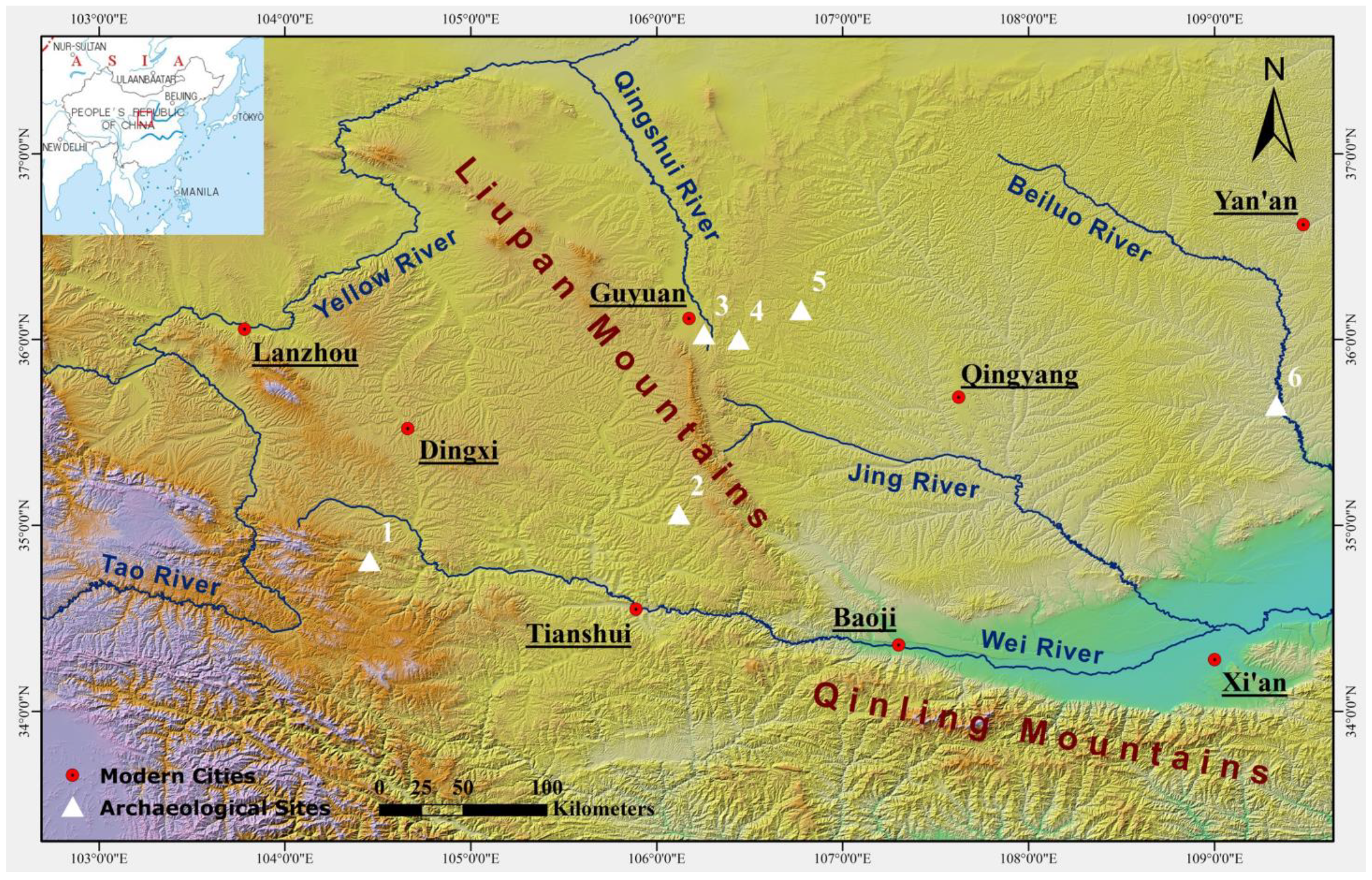
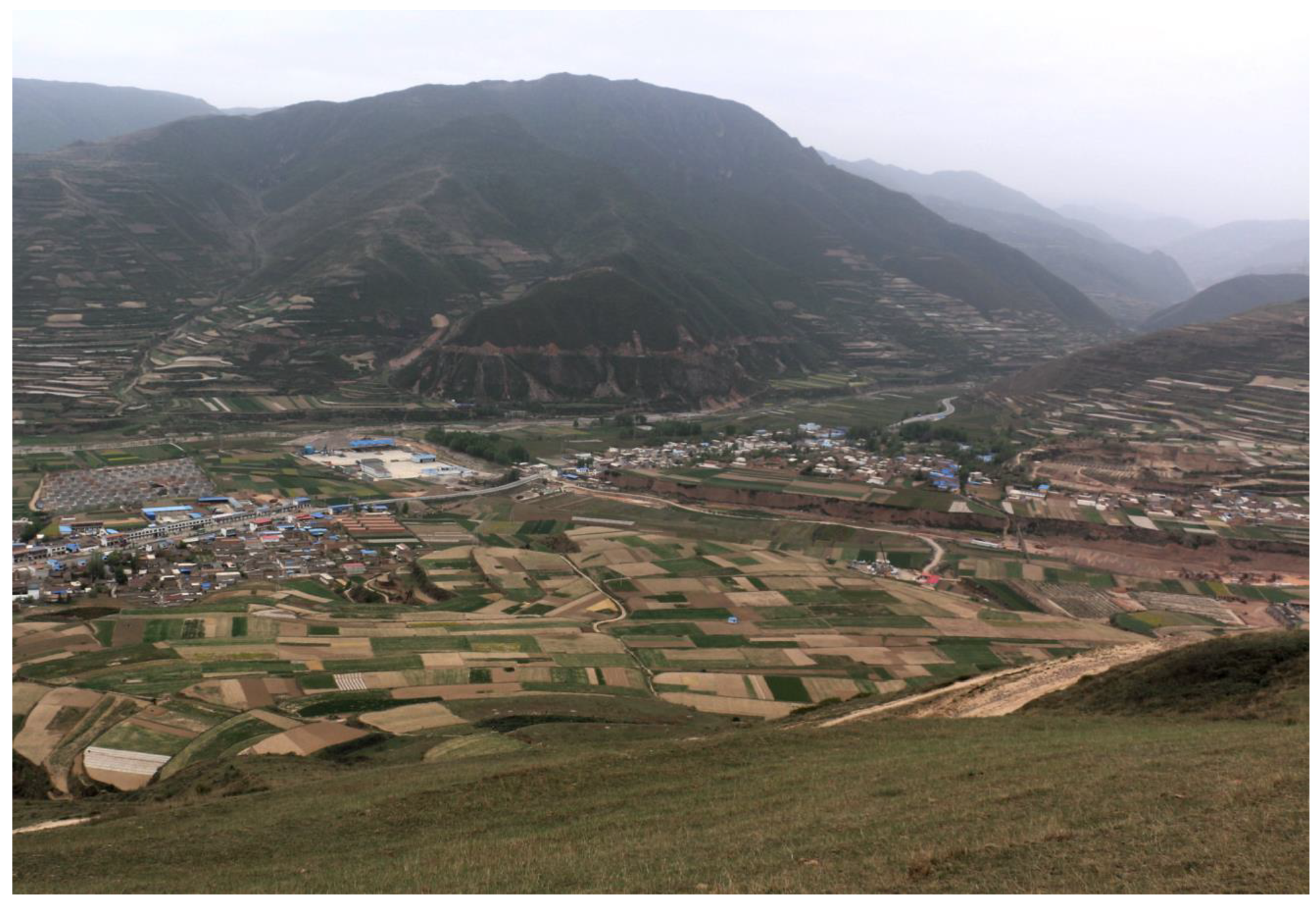
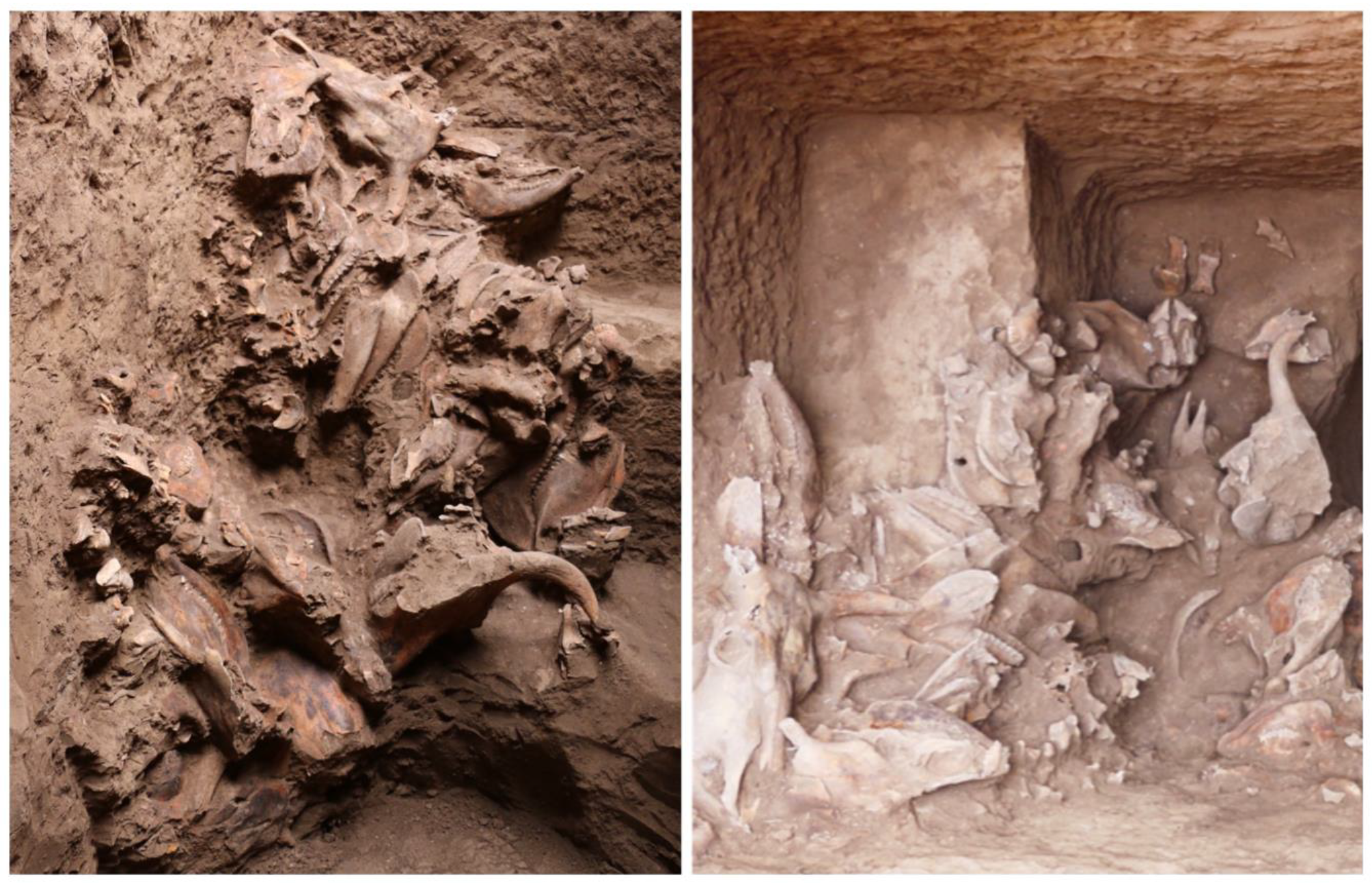
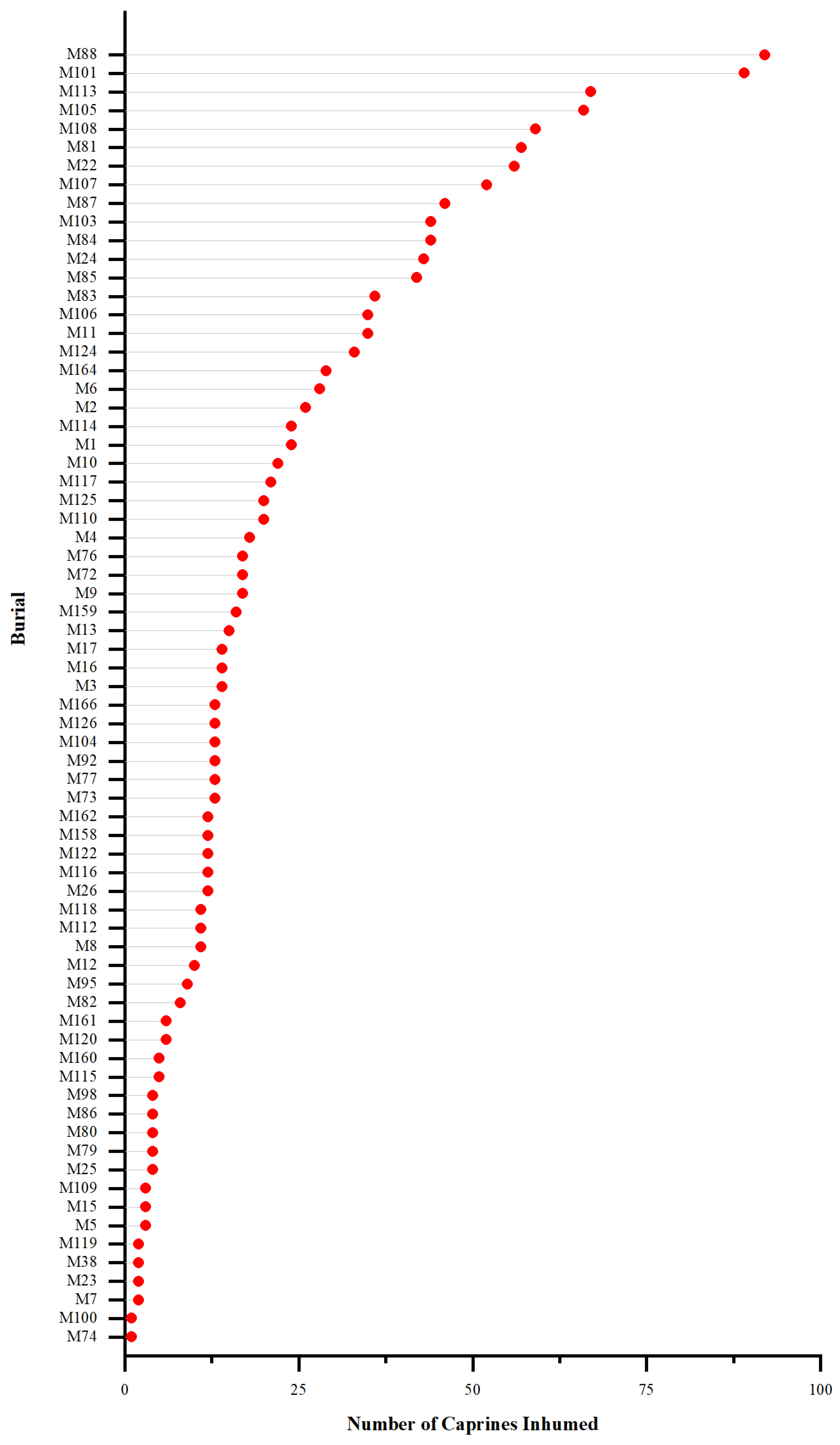
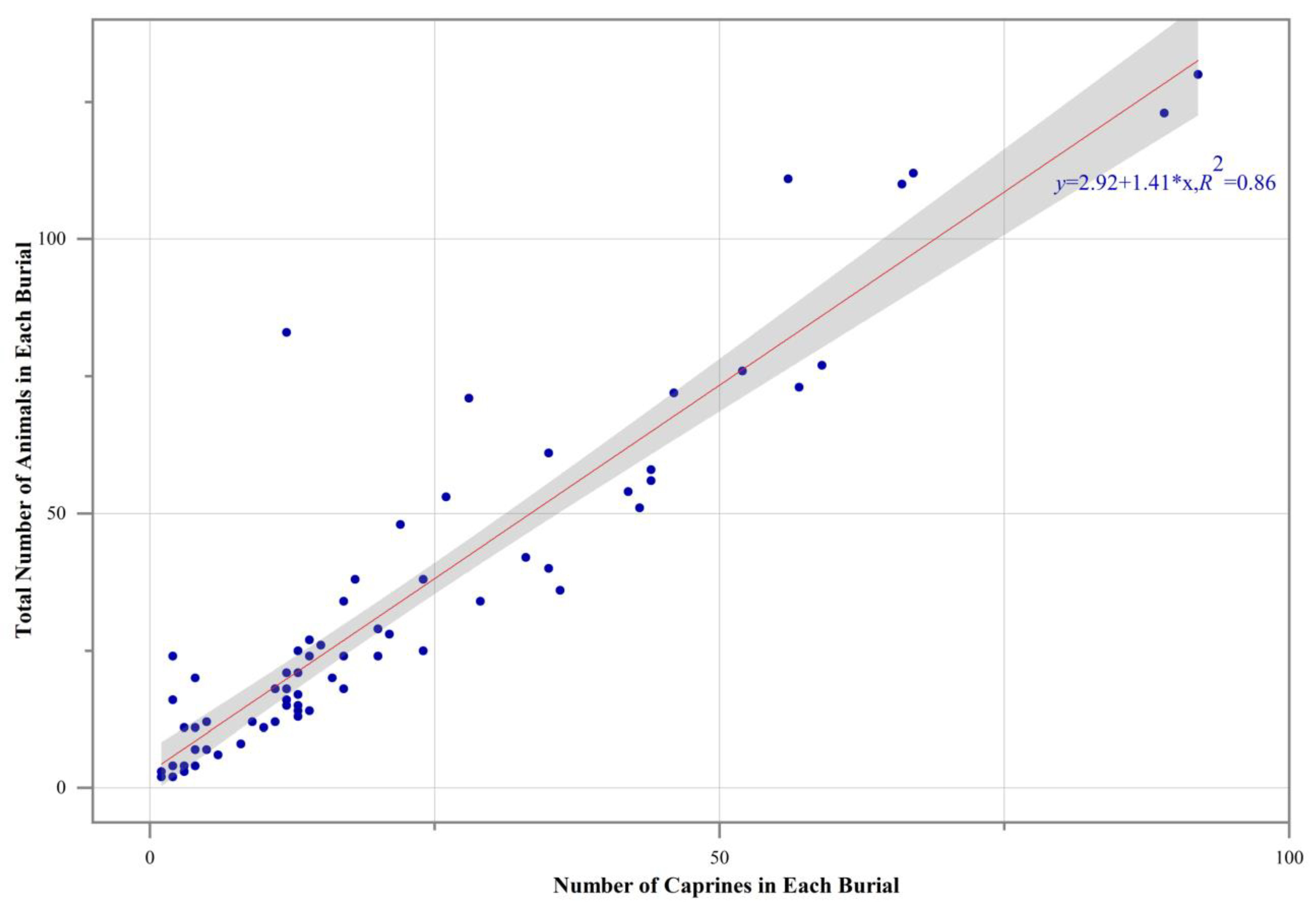
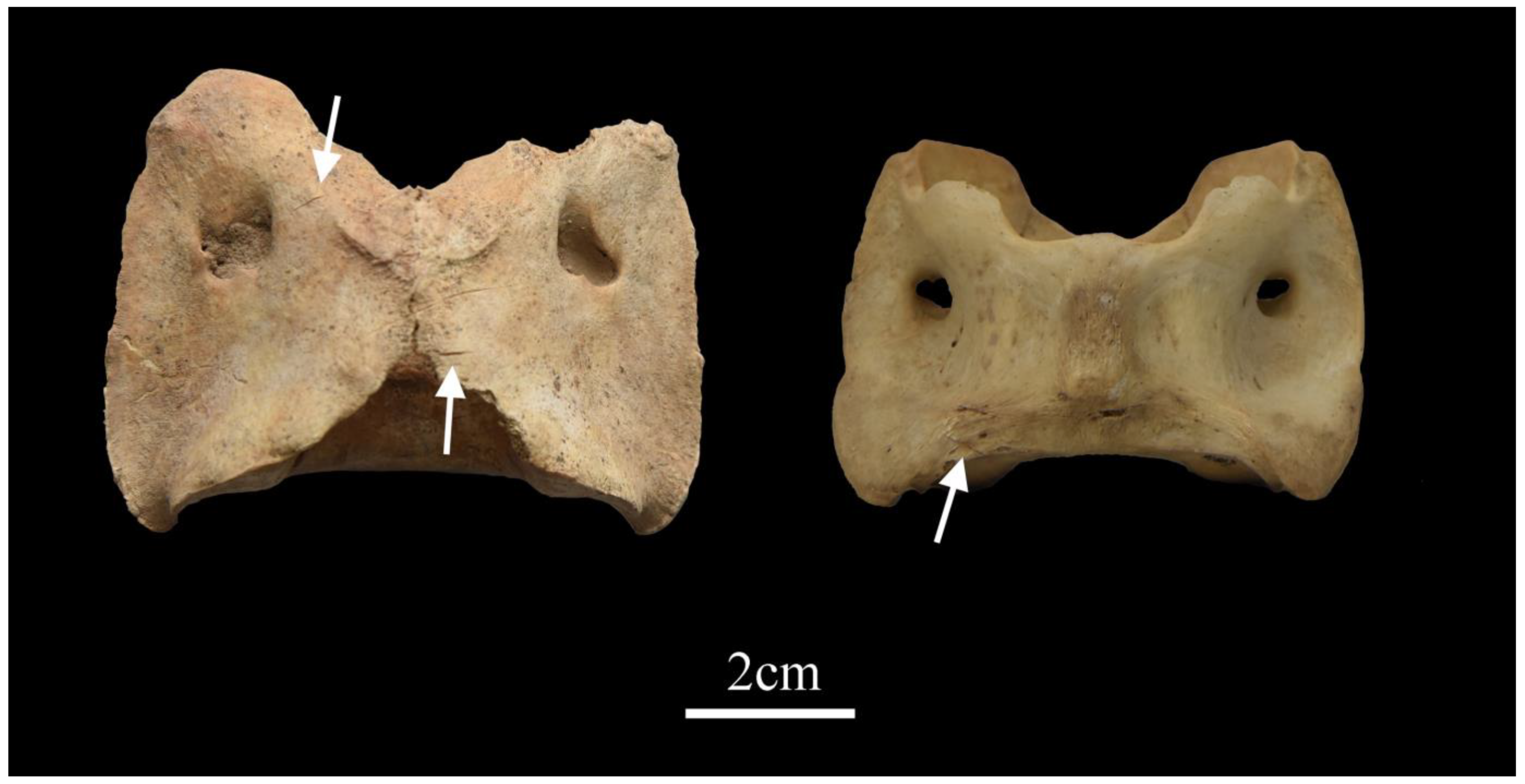
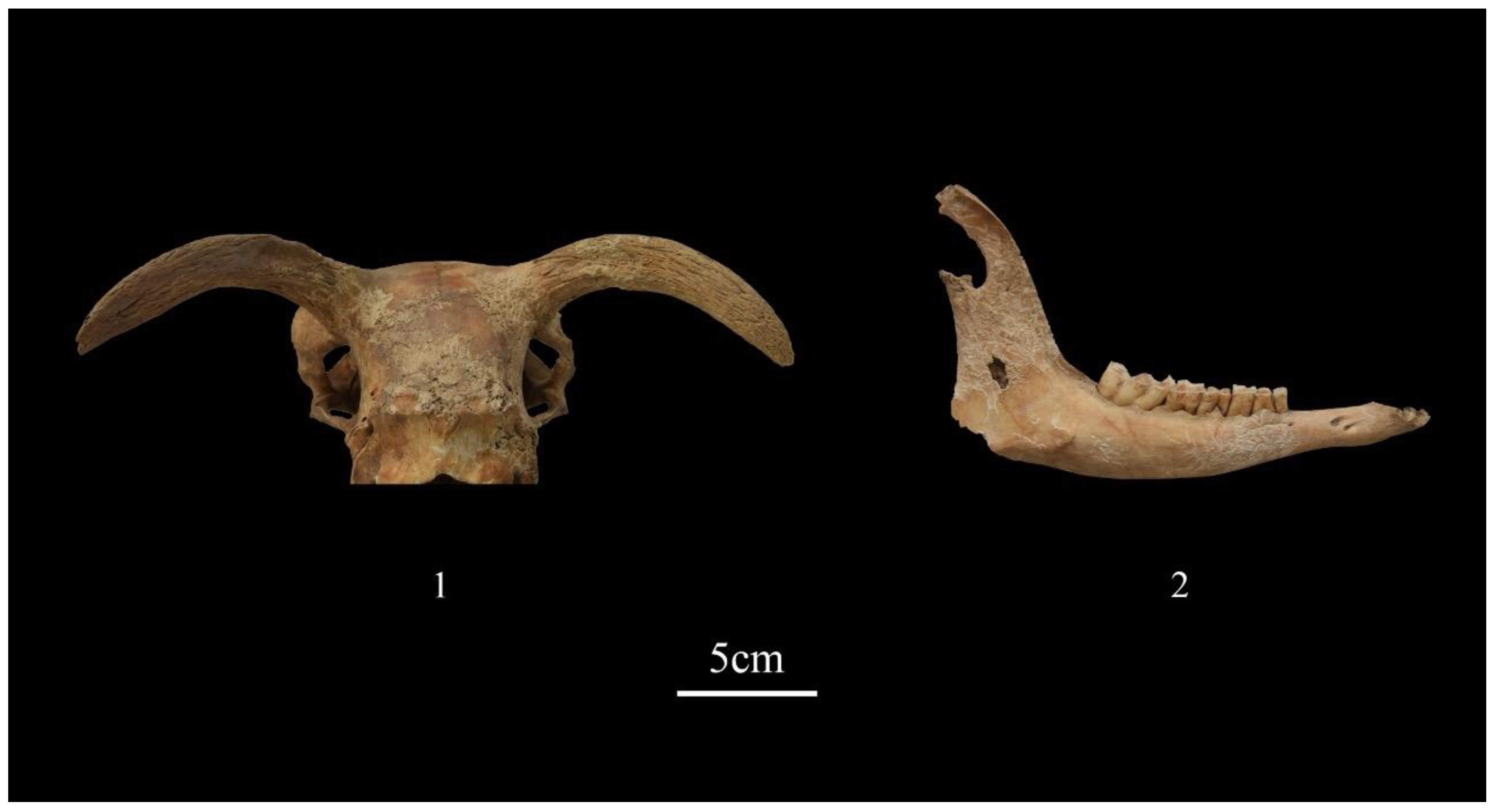
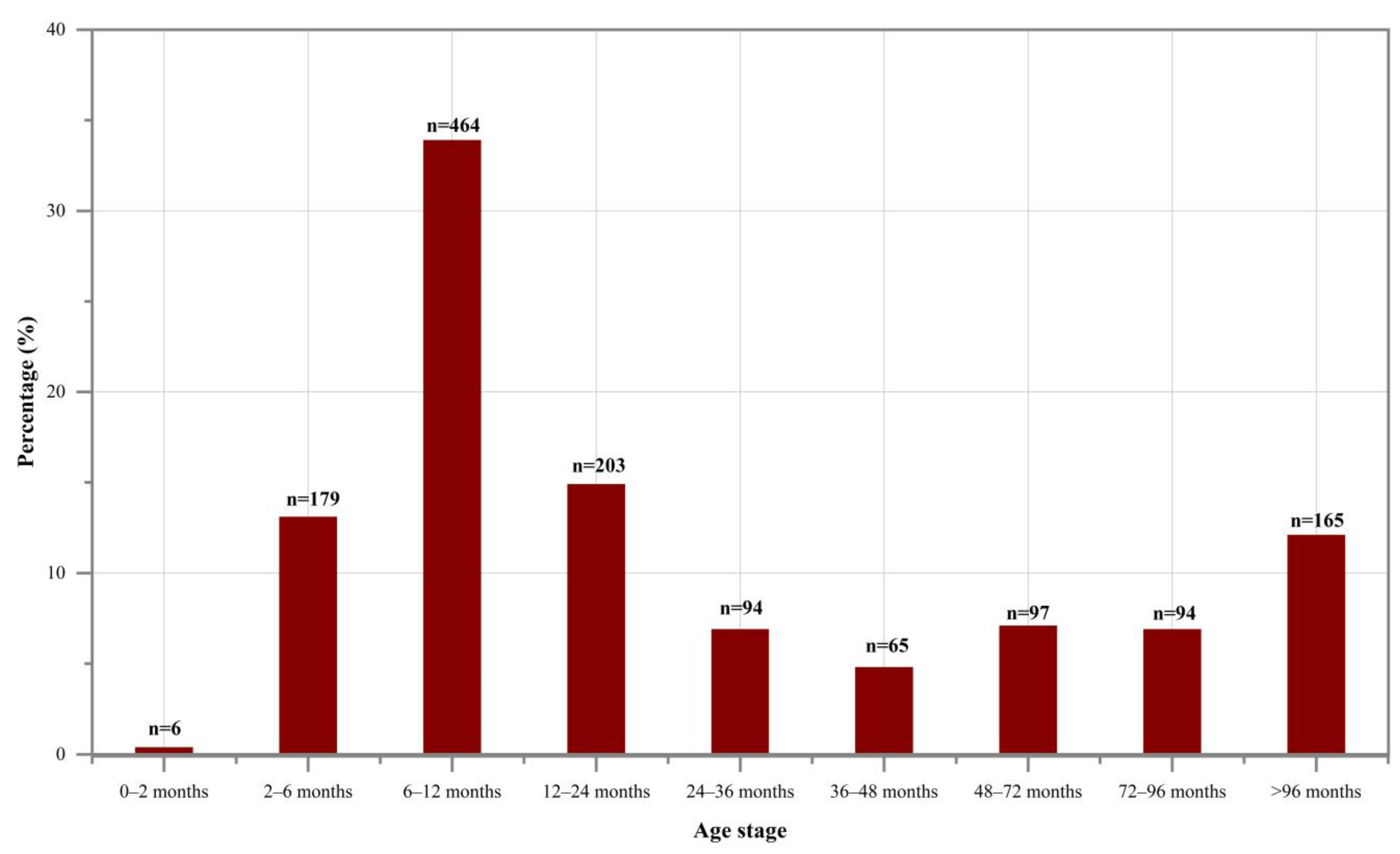
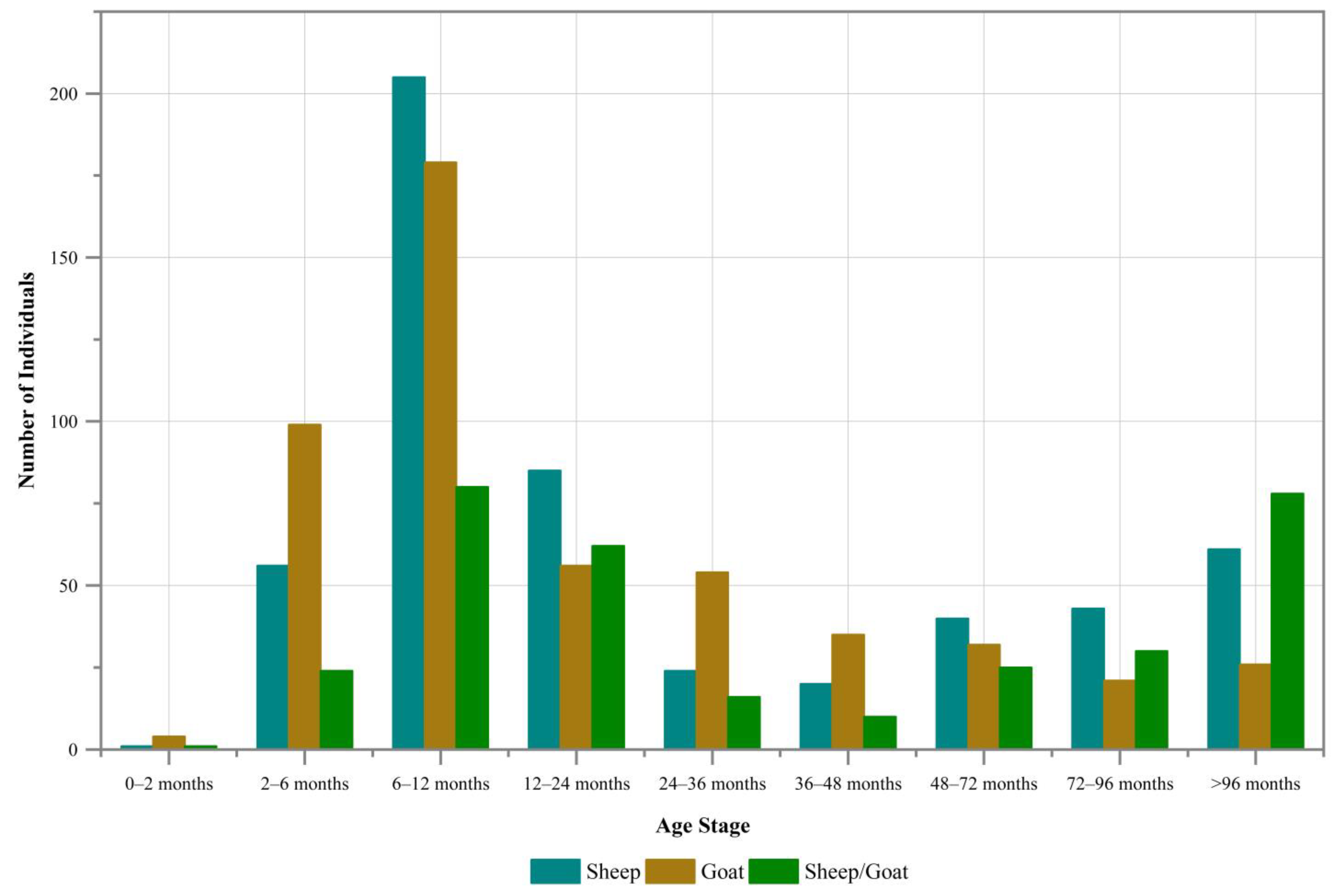
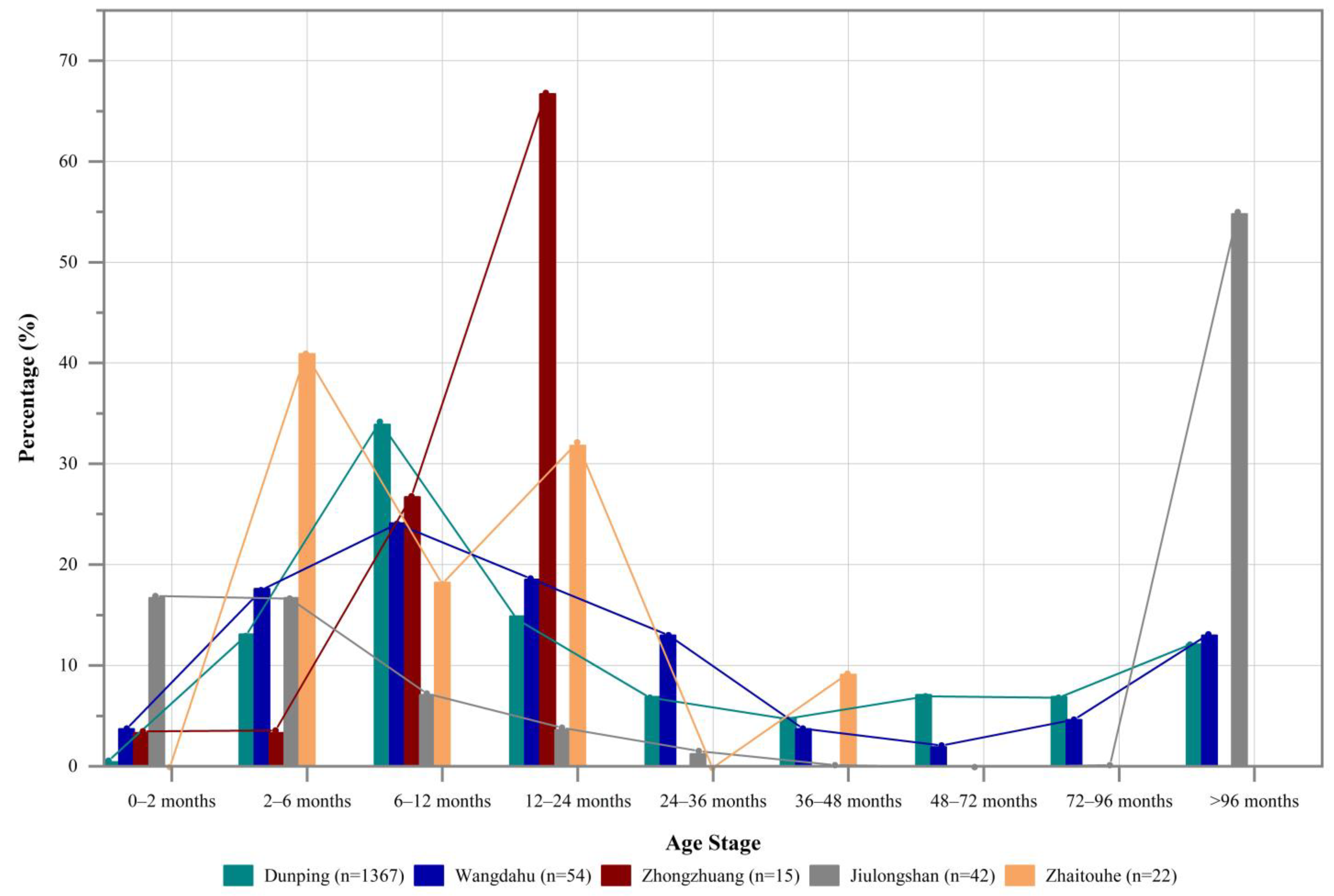
| Species | NISP | MNI | % of Total MNI of Caprines from the 70 Burials | % of Total MNI of Animals from the 70 Burials |
|---|---|---|---|---|
| Sheep | 1532 | 576 | 38.1 | 24.7 |
| Goat | 1388 | 544 | 36.0 | 23.3 |
| Sheep/Goat | 1507 | 391 | 25.9 | 16.8 |
| Total | 4427 | 1511 | 100.0 | 64.7 |
| Layer | Animal Species (by MNI) | Caprine Skeletal Element (by NISP) | |||||||
|---|---|---|---|---|---|---|---|---|---|
| Horse | Cattle | Caprine | Cranium | Mandible | Isolated Tooth | Atlas | Phalanges | Others | |
| Layer 1 | 1 | 4 | 4 | 4 | 7 | 1 | 4 | 13 | 0 |
| Layer 2 | 1 | 4 | 0 | 0 | 0 | 0 | 0 | 0 | 0 |
| Layer 3 | 0 | 11 | 7 | 7 | 12 | 0 | 1 | 1 | 0 |
| Layer 4 | 1 | 0 | 0 | 0 | 0 | 0 | 0 | 0 | 0 |
| Layer 5 | 0 | 0 | 3 | 3 | 6 | 0 | 2 | 7 | 0 |
| Layer 6 | 0 | 2 | 7 | 6 | 13 | 0 | 3 | 5 | 0 |
| Layer 7 | 0 | 4 | 10 | 8 | 19 | 0 | 2 | 2 | 0 |
| Layer 8 | 0 | 9 | 6 | 4 | 12 | 0 | 3 | 11 | 0 |
| Layer 9 | 1 | 7 | 7 | 7 | 7 | 0 | 1 | 6 | 0 |
| Layer 10 | 6 | 3 | 0 | 0 | 0 | 0 | 0 | 0 | 0 |
| Layer 11 | 0 | 0 | 4 | 2 | 6 | 0 | 2 | 0 | 0 |
| Layer 12 | 0 | 1 | 0 | 0 | 0 | 0 | 0 | 0 | 0 |
| Total | 10 | 45 | 48 | 41 | 82 | 1 | 18 | 45 | 0 |
| Layer | Animal Species (by MNI) | Caprine Skeletal Element (by NISP) | |||||||
|---|---|---|---|---|---|---|---|---|---|
| Horse | Cattle | Caprine | Cranium | Mandible | Isolated Tooth | Atlas | Phalange | Others | |
| Layer 1 | 0 | 5 | 15 | 14 | 25 | 0 | 1 | 6 | 0 |
| Layer 2 | 0 | 1 | 1 | 1 | 2 | 0 | 0 | 1 | 0 |
| Layer 3 | 0 | 3 | 2 | 1 | 3 | 0 | 0 | 0 | 0 |
| Layer 4 | 0 | 9 | 29 | 29 | 49 | 0 | 15 | 9 | 0 |
| Layer 5 | 4 | 14 | 27 | 24 | 47 | 0 | 12 | 66 | 0 |
| Layer 6 | 0 | 2 | 18 | 17 | 32 | 0 | 8 | 13 | 0 |
| Total | 4 | 34 | 92 | 86 | 158 | 0 | 36 | 95 | 0 |
| Layer | Animal Species (by MNI) | Caprine Skeletal Element (by NISP) | |||||||
|---|---|---|---|---|---|---|---|---|---|
| Horse | Cattle | Caprine | Cranium | Mandible | Isolated Tooth | Atlas | Phalange | Others | |
| Layer 1 | 1 | 2 | 7 | 5 | 12 | 1 | 4 | 6 | 1 |
| Layer 2 | 0 | 0 | 6 | 4 | 11 | 1 | 0 | 5 | 0 |
| Layer 3 | 0 | 3 | 3 | 2 | 6 | 6 | 3 | 0 | 0 |
| Layer 4 | 2 | 1 | 4 | 2 | 7 | 0 | 0 | 0 | 0 |
| Total | 3 | 6 | 20 | 13 | 36 | 8 | 7 | 11 | 1 |
Disclaimer/Publisher’s Note: The statements, opinions and data contained in all publications are solely those of the individual author(s) and contributor(s) and not of MDPI and/or the editor(s). MDPI and/or the editor(s) disclaim responsibility for any injury to people or property resulting from any ideas, methods, instructions or products referred to in the content. |
© 2023 by the authors. Licensee MDPI, Basel, Switzerland. This article is an open access article distributed under the terms and conditions of the Creative Commons Attribution (CC BY) license (https://creativecommons.org/licenses/by/4.0/).
Share and Cite
Li, Y.; Cheng, R.; Huang, Z.; Mao, X.; Liu, K.; Wang, Q.; Hou, F.; Mao, R.; Zhang, C. Animals in Mortuary Practices of Bronze-Age Pastoral Societies: Caprine Use at the Site of Dunping in Northwestern China. Animals 2023, 13, 3794. https://doi.org/10.3390/ani13243794
Li Y, Cheng R, Huang Z, Mao X, Liu K, Wang Q, Hou F, Mao R, Zhang C. Animals in Mortuary Practices of Bronze-Age Pastoral Societies: Caprine Use at the Site of Dunping in Northwestern China. Animals. 2023; 13(24):3794. https://doi.org/10.3390/ani13243794
Chicago/Turabian StyleLi, Yue, Ruoxin Cheng, Zexian Huang, Xiaolu Mao, Kexin Liu, Qianwen Wang, Furen Hou, Ruilin Mao, and Chengrui Zhang. 2023. "Animals in Mortuary Practices of Bronze-Age Pastoral Societies: Caprine Use at the Site of Dunping in Northwestern China" Animals 13, no. 24: 3794. https://doi.org/10.3390/ani13243794
APA StyleLi, Y., Cheng, R., Huang, Z., Mao, X., Liu, K., Wang, Q., Hou, F., Mao, R., & Zhang, C. (2023). Animals in Mortuary Practices of Bronze-Age Pastoral Societies: Caprine Use at the Site of Dunping in Northwestern China. Animals, 13(24), 3794. https://doi.org/10.3390/ani13243794








